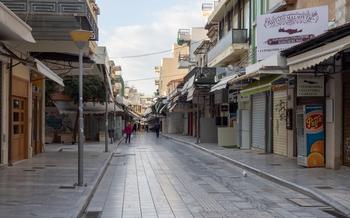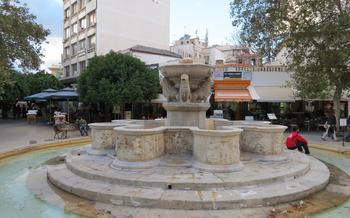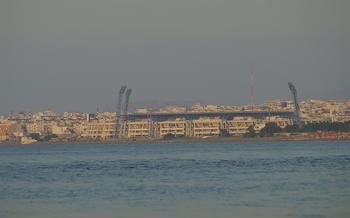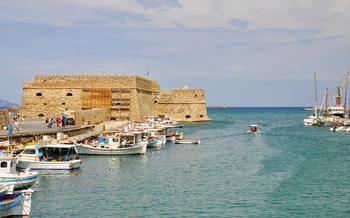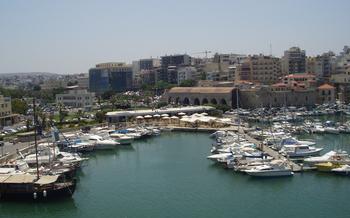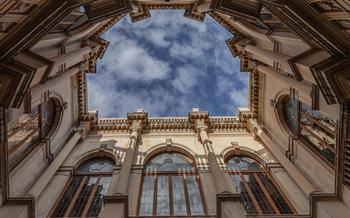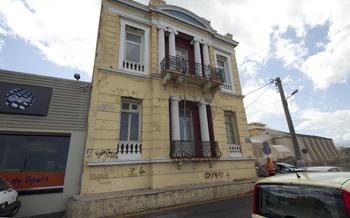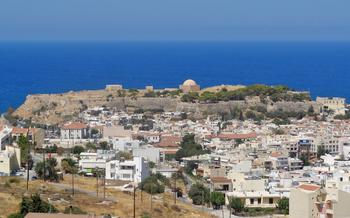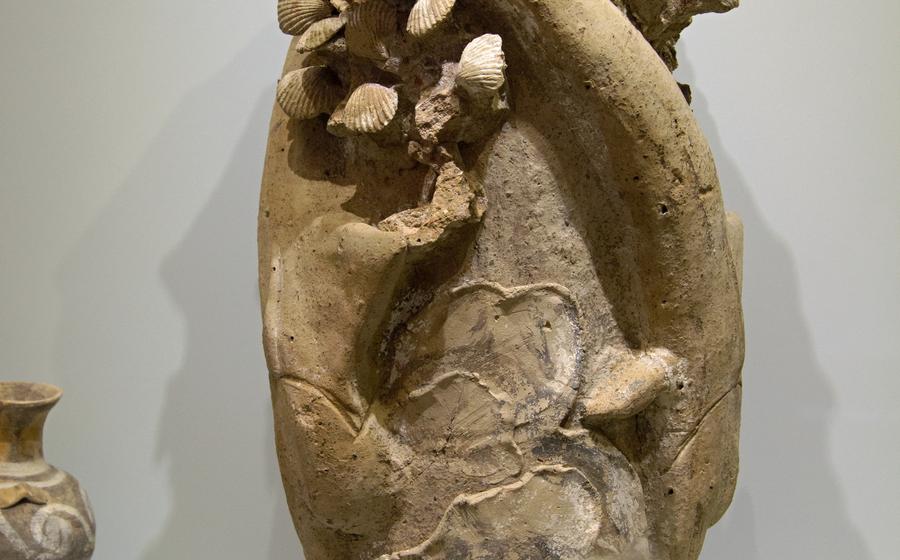
The Minoan Palace of Phaistos
- The Minoan Palace of Phaistos: A Journey Through Time
- Unveiling the History of Phaistos
- Exploring the Palace Grounds
- Admire the Throne Room's Majesty
- Discover the Royal Apartments
- Step into the Workshops
- Explore the Residential Quarters
- Marvel at the Phaistos Disc
- Visit the Phaistos Museum
- Plan Your Visit to Phaistos
- Transportation to Phaistos
- Accommodation near Phaistos
- Dining Options near Phaistos: A Culinary Journey through Crete
- Combine Your Visit with Other Attractions
- Insider Tip: Unveiling the Secrets of the Phaistos Disc
The Minoan Palace of Phaistos: A Journey Through Time
In the heart of Crete, nestled amidst rolling hills and olive groves, lies the ancient Minoan Palace of Phaistos, a testament to the ingenuity and grandeur of the enigmatic Minoan civilization. Built around 1700 BC, it stands as one of the most significant Bronze Age palaces on the island, rivaling the renowned Palace of Knossos in its architectural prowess and historical importance.
The Minoan Palace of Phaistos served as the political, economic, and religious center of the region, a bustling hub where trade, craft, and administrative activities converged. Its unique architectural features, including the massive central courtyard, the intricate staircases, and the elaborate throne room, provide a glimpse into the advanced urban planning and engineering skills of the Minoans.
Among the palace's most intriguing artifacts is the renowned Phaistos Disc, a mysterious clay disc inscribed with an undeciphered script, sparking centuries of debate and speculation. This enigmatic artifact, along with the vibrant frescoes adorning the palace walls, offers tantalizing clues to the rich cultural and religious life of the Minoans, inviting visitors to delve into the depths of their fascinating civilization.
Unveiling the History of Phaistos
The Minoan civilization, which flourished on Crete during the Bronze Age, remains shrouded in mystery. The Minoans were a seafaring people who developed a complex and advanced culture, leaving behind impressive architectural feats such as the Palace of Phaistos. This grand palace served as a political and economic center, showcasing the Minoans' remarkable achievements in governance and trade.
Excavations at Phaistos began in the early 20th century, led by the Italian archaeologist Luigi Pernier. Pernier's team uncovered a vast and intricate palace complex, revealing the sophisticated urban planning and engineering skills of the Minoans. The palace's restoration has been an ongoing effort, with archaeologists working meticulously to preserve and showcase its grandeur for future generations.
Exploring the Palace Grounds
The Minoan Palace of Phaistos boasts an intricate layout that showcases the advanced planning and architectural prowess of its builders. As you enter the palace grounds, you'll be greeted by a central courtyard, the heart of the palace. This vast open space served as a gathering place for the palace's inhabitants and visitors, hosting religious ceremonies, festivals, and other social events.
The courtyard is surrounded by a series of grand staircases that lead to the various levels of the palace. These staircases are not just functional but also architectural masterpieces, demonstrating the Minoan's mastery of engineering and design. The staircases feature intricate patterns and decorative elements, adding to the overall grandeur of the palace.
As you explore the palace grounds, you'll notice the clever use of light and ventilation. The palace's architects strategically positioned windows and openings to allow natural light to flood the interior spaces, creating a bright and airy atmosphere. Additionally, the palace's design incorporates ventilation systems that ensure a comfortable indoor climate even during the hot summer months.
Admire the Throne Room's Majesty
At the heart of the Minoan Palace of Phaistos lies the throne room, a chamber that exudes grandeur and power. As you step inside, you can't help but be awestruck by the sheer size and opulence of this space. The throne itself, carved from a single block of alabaster, is a testament to the craftsmanship of the Minoan artisans. Its intricate carvings depict scenes of nature and mythology, adding to the room's mystical aura.
The throne is positioned at the far end of the room, elevated on a platform and surrounded by vibrant frescoes. These paintings, though faded with time, still retain their vivid colors and depict tales of royal ceremonies, hunting expeditions, and religious rituals. The throne room was not just a place of governance but also a sacred space, where the king, as the embodiment of divine power, conducted important rituals and ceremonies.
The overall effect of the throne room is one of awe and reverence. It's easy to imagine the Minoan rulers seated on their throne, surrounded by their court, issuing edicts and making decisions that shaped the course of their civilization. The throne room is a powerful reminder of the grandeur and sophistication of the Minoan civilization, and a must-see for anyone interested in ancient history and archaeology.
Discover the Royal Apartments
The royal apartments at the Minoan Palace of Phaistos offer an intimate glimpse into the lives of the rulers and their families. The queen's chambers are particularly opulent, featuring intricate frescoes and elegant furnishings. These chambers were likely used for both official and private purposes, with areas designated for sleeping, bathing, and entertaining guests. The king's quarters, while slightly more austere, are no less impressive, showcasing the power and prestige of the Minoan monarchy.
The storerooms, located adjacent to the royal apartments, provide further insights into the lavish lifestyle of the Phaistos rulers. These storerooms were filled with an array of treasures, including precious metals, jewelry, and imported goods from across the Mediterranean. The sheer quantity and variety of items found in these storerooms attest to the wealth and prosperity of the Minoan kingdom.
Step into the Workshops
The Minoan Palace of Phaistos was not just a political and religious center; it was also a hub of industrial activity. Within the palace complex, skilled artisans plied their trade, producing exquisite pottery, intricate jewelry, and finely crafted metalwork.
The palace workshops were a testament to the Minoans' advanced craftsmanship. Potters used a variety of techniques to create beautiful and functional vessels, from simple cups and bowls to elaborate painted jars. Metalworkers demonstrated their mastery in forging tools, weapons, and decorative objects from copper, bronze, and gold.
The workshops were not merely production centers; they were also places of innovation and experimentation. Minoan artisans were constantly refining their techniques and developing new designs, pushing the boundaries of their craft. Their creations were not only beautiful but also highly functional, reflecting the Minoans' practical and artistic sensibilities.
These workshops played a vital role in the palace economy. The goods produced here were used not only by the palace inhabitants but also traded with other regions, contributing to the Minoans' wealth and influence.
Exploring the workshops of the Minoan Palace of Phaistos is a journey into the heart of this ancient civilization's industrial prowess. Here, visitors can gain a glimpse into the skills, creativity, and ingenuity of the Minoan people, who left an indelible mark on the history of craftsmanship and design.
Explore the Residential Quarters
The Minoan Palace of Phaistos was not just a political and economic hub; it was also home to a vibrant community. Step into the residential quarters and gain insights into the daily lives of the palace's inhabitants. These quarters, located in the palace's western wing, provide a glimpse into the social hierarchy that existed within the palace walls.
The residential quarters comprise a series of rooms and apartments, each varying in size and amenities. The larger apartments, likely reserved for high-ranking officials or members of the royal family, feature private bathrooms and storage areas. The smaller rooms, perhaps occupied by servants or workers, offer a more basic living space.
The layout of the residential quarters reveals a clear separation of spaces. The northern section, with its larger and more elaborate apartments, was likely reserved for the palace's elite. The southern section, with its smaller and more modest rooms, housed the palace's workforce.
Exploring the residential quarters is like stepping back in time and imagining the daily routines of the palace's inhabitants. Picture the palace servants scurrying about, attending to the needs of the royal family. Imagine the artisans crafting exquisite pottery and metalwork in their workshops. And envision the royal family members themselves, holding court, feasting, and conducting the affairs of their kingdom.
Marvel at the Phaistos Disc
Discovered within the palace's walls, the enigmatic Phaistos Disc remains one of the most captivating artifacts from the Minoan era. This circular clay disc, adorned with a spiral of mysterious symbols, has puzzled scholars and archaeologists for over a century. Its purpose and origin remain shrouded in mystery, giving rise to a multitude of theories and speculations.
Some believe it to be a form of ancient writing, perhaps even a precursor to the modern alphabet. Others suggest it may have been a religious symbol or a navigational tool. The disc's unique symbols, unlike any other known script, have fueled the fascination and intrigue surrounding it.
To this day, the Phaistos Disc continues to be a source of scholarly debate and research. While its secrets remain hidden, the allure of the disc lies in its ability to transport us back in time, to a civilization that thrived thousands of years ago and left behind enduring enigmas for us to ponder.
Visit the Phaistos Museum
The Phaistos Museum, located a short walk from the palace, is a treasure trove of artifacts that provide a deeper understanding of the site and its history. It houses a remarkable collection of artifacts unearthed during excavations at Phaistos and the surrounding area. From intricate pottery and bronze tools to stunning jewelry and religious objects, the museum offers a glimpse into the daily lives and artistic achievements of the Minoans.
Among the highlights of the museum is the Phaistos Disc, an enigmatic circular clay tablet covered in a unique script that has yet to be deciphered. The disc, discovered in the palace, has captivated scholars and historians worldwide, and its origin and purpose remain a subject of ongoing debate.
The museum also features modern exhibits that bring the Minoan civilization to life through interactive displays, multimedia presentations, and hands-on activities. These exhibits provide valuable insights into the palace's architecture, the Minoan economy, and the social and religious practices of this ancient civilization.
A visit to the Phaistos Museum is an essential complement to exploring the palace itself. It offers a comprehensive understanding of the site's history, culture, and significance, leaving visitors with a deeper appreciation for the ingenuity and achievements of the Minoan people.
Plan Your Visit to Phaistos
Plan Your Visit to Phaistos
To fully immerse yourself in the wonders of the Minoan Palace of Phaistos, planning your visit is essential. The best time to explore this ancient site is during the shoulder seasons (April-May and September-October) when the weather is pleasant, and the crowds are smaller. Guided tours are highly recommended, as they provide insightful commentary and historical context, enhancing your understanding of the palace's significance. These tours typically last around two hours and depart regularly from the ticket office.
The palace is equipped with essential amenities, including restrooms, a small cafe, and a gift shop where you can purchase souvenirs and informative books about the site. Remember to wear comfortable shoes, as the palace grounds involve some walking on uneven surfaces. Sunscreen, a hat, and sunglasses are also advisable, especially during the summer months.
Transportation to Phaistos
Phaistos, a captivating historical gem, lies approximately 60 kilometers south of Heraklion, inviting you on an intriguing journey through time. Reaching this ancient site is a breeze, with various transportation options at your disposal.
Public Transportation:
If you prefer a hassle-free and budget-friendly option, hop on a bus from Heraklion's central bus station. The journey takes about an hour and 30 minutes, offering a scenic ride through the picturesque Cretan countryside. Buses depart frequently throughout the day, ensuring flexibility in planning your visit.
Renting a Car:
For those seeking the freedom to explore at their own pace, renting a car is an excellent choice. The drive from Heraklion to Phaistos takes approximately one hour, allowing you to relish the stunning views along the way. Car rental agencies are readily available in Heraklion, providing a range of vehicles to suit your needs.
Organized Tours:
If you prefer a guided experience, joining an organized tour from Heraklion is a great option. These tours typically include transportation to and from Phaistos, as well as the services of a knowledgeable guide who will share insights into the site's history and significance. Organized tours offer a hassle-free and informative way to explore this ancient wonder.
Accommodation near Phaistos
To fully immerse yourself in the history and culture of Phaistos, consider staying overnight in the vicinity. Several hotels and guesthouses are situated nearby, offering a range of amenities and services to ensure a comfortable and memorable stay.
For those seeking a luxurious experience, the Phaistos Palace Hotel stands out with its elegant rooms, panoramic views, and a swimming pool. The hotel's convenient location allows for easy access to the palace and other attractions.
More budget-conscious travelers might prefer the cozy atmosphere of the Phaistos Village Hotel. This charming hotel offers comfortable rooms, a friendly staff, and a delicious breakfast to kick-start your day of exploration.
Whichever accommodation you choose, be sure to book in advance, especially during the peak tourist season, to avoid any disappointment.
Dining Options near Phaistos: A Culinary Journey through Crete
A visit to Phaistos is not complete without savoring the delectable flavors of traditional Cretan cuisine. Indulge in mouthwatering dishes infused with fresh, locally sourced ingredients that showcase the region's culinary heritage.
For a truly authentic experience, head to one of the charming tavernas nestled in the picturesque villages surrounding Phaistos. These family-run establishments offer a warm and inviting atmosphere, where you can savor traditional recipes that have been passed down through generations.
Be sure to try the region's signature dish, "dakos," a flavorful combination of barley rusk topped with fresh tomatoes, creamy feta cheese, and a drizzle of olive oil. Another must-try is "kalitsounia," delicious pastries filled with local greens, cheese, or meat.
For a taste of the sea, sample the freshly caught fish and seafood. Grilled octopus, succulent shrimp, and tender calamari are popular choices, often served with a tangy lemon-olive oil sauce.
Don't forget to end your meal with a sweet treat. The island's traditional desserts, such as "loukoumades" (fried dough balls drizzled with honey and cinnamon) and "baklava" (filo pastry filled with chopped nuts and sweetened with syrup), are a delightful way to conclude your culinary journey.
To enhance your dining experience, choose a restaurant with panoramic views of the surrounding countryside or the sparkling Mediterranean Sea. As you savor the flavors of Cretan cuisine, let the breathtaking scenery add an unforgettable touch to your meal.
Combine Your Visit with Other Attractions
Beyond the allure of the Minoan Palace of Phaistos, the region offers a wealth of other captivating attractions. Bask in the Mediterranean sun and indulge in water sports at the pristine beaches of Matala and Kommos, just a short drive away. Immerse yourself further into ancient history by exploring the archaeological sites of Agia Triada and Gortyn, where you can marvel at well-preserved ruins and artifacts. Take advantage of your proximity to the vibrant city of Heraklion, the island's capital, and delve into its rich history, vibrant culture, and lively nightlife. With so much to see and experience, the region surrounding Phaistos promises a journey filled with unforgettable moments and lasting memories.
Insider Tip: Unveiling the Secrets of the Phaistos Disc
The Phaistos Disc remains one of archaeology's most intriguing enigmas, captivating scholars and history buffs alike. During your visit, you can delve deeper into the ongoing efforts to decipher its secrets. Join a guided tour that sheds light on the latest research and theories surrounding the disc. Learn about the challenges faced by experts as they attempt to unravel its enigmatic script. The thrill of being part of an ongoing historical mystery adds an extra layer of excitement to your visit. Who knows, you might just come up with your own ingenious theory to contribute to the ongoing debate!

